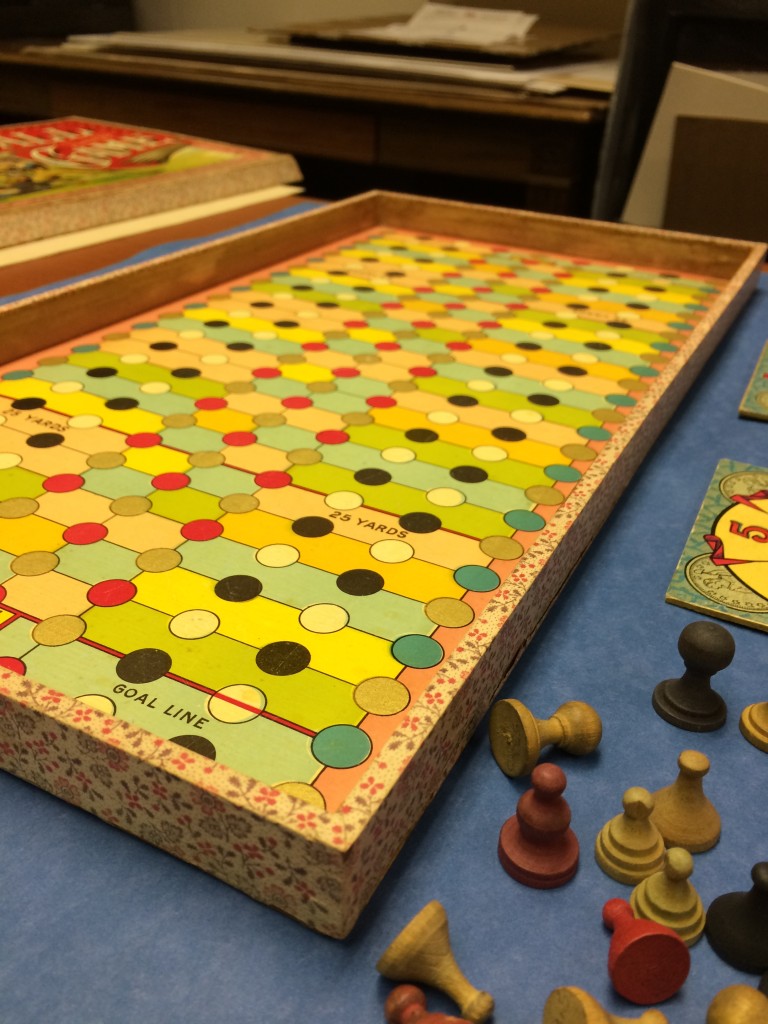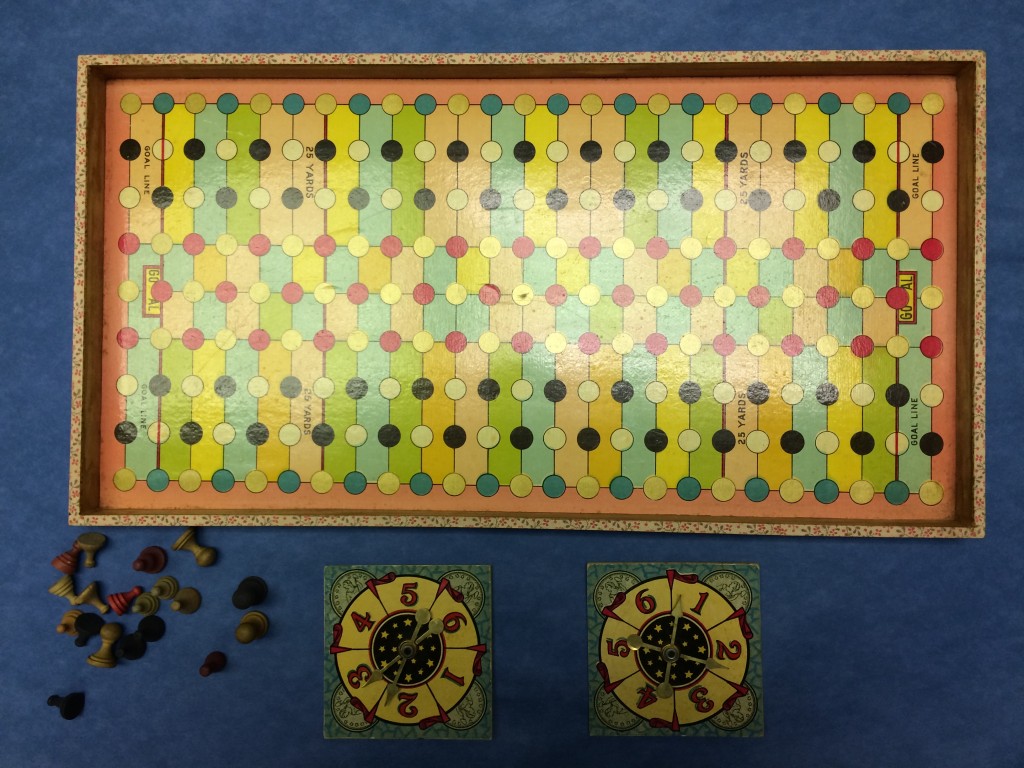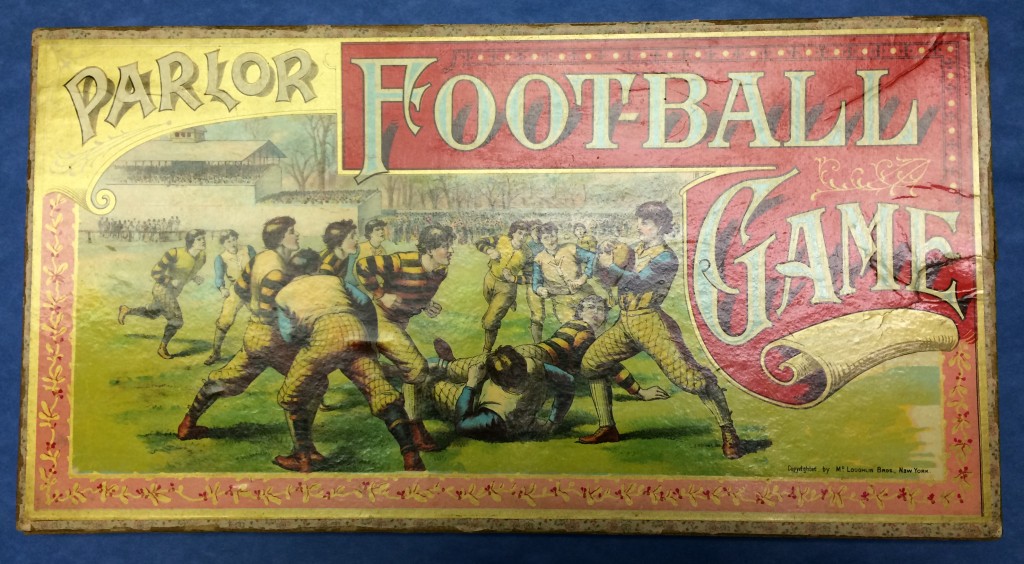 While trolling for children’s books and games at the Papermania fair held several weeks ago in the basement of the Hartford Civic Center (you could hear the marching band playing for the UConn men’s basketball game upstairs), I made the happy discovery of this aptly titled Parlor Foot-ball Game, issued by picture book and game publisher McLoughlin Brothers in 1891. Its magnificently chromolithographed cover is nothing short of arresting: healthy, attractive (and yes, look-alike) young men competing for control of a ball that resembles more of a soccer ball or basketball than a modern elliptical football. No dirt, grass stains, or blood sully this wholesome game. If anything, the players appear to be in that ambiguous space between boys and men: they are all clean-shaven and wear the same pageboy haircuts. Their protective gear is minimal—although some wear quilted knickers and several players have buckled shin pads.
While trolling for children’s books and games at the Papermania fair held several weeks ago in the basement of the Hartford Civic Center (you could hear the marching band playing for the UConn men’s basketball game upstairs), I made the happy discovery of this aptly titled Parlor Foot-ball Game, issued by picture book and game publisher McLoughlin Brothers in 1891. Its magnificently chromolithographed cover is nothing short of arresting: healthy, attractive (and yes, look-alike) young men competing for control of a ball that resembles more of a soccer ball or basketball than a modern elliptical football. No dirt, grass stains, or blood sully this wholesome game. If anything, the players appear to be in that ambiguous space between boys and men: they are all clean-shaven and wear the same pageboy haircuts. Their protective gear is minimal—although some wear quilted knickers and several players have buckled shin pads.
It is the team jerseys that reveal more about the players and place of football in American culture during the Gilded Age. Half of them wear the “Y” of the Yale University Bulldogs, while the other half sport the orange and black horizontally striped jerseys of the Princeton University Tigers, reflecting the sport’s popularity on two exclusive college campuses. In 1891, the sport of college football was barely more than two decades old, and both Yale and Princeton had the earliest teams. Yale first competed in 1872, and by 1891 the team was coached by Walter Camp, who is now known as the Father of Football for his innovative work in transforming the game from English rugby to the snap and tackle dominated plays along the line of scrimmage that became characteristic of American football. Princeton and its nearby competitor Rutgers are cre dited with having the oldest football teams in the world, both established in 1869. Princeton dominated the game, winning some 22 of the 40 national titles played between 1872 and 1900.
dited with having the oldest football teams in the world, both established in 1869. Princeton dominated the game, winning some 22 of the 40 national titles played between 1872 and 1900.
Also fascinating is the carefully composed pastoral background for this box top image. Green leafy trees border the field, providing shade for an early fall day free from wind, rain, or snow. Even the spectators seem to be neatly arranged between the covered grandstand on the left, the bleachers in the middle, and the standing spectators on the far right, who seem to be well-dressed college men and their girlfriends. It is as though the box image is giving us visual instructions for the performance of the game as a social event.
 Like many late nineteenth-century games, the actual board game is governed by rules that seem ponderous to the modern eye. The action is confined to a rectangular board marked by yards and goal spaces/goal lines on either side. The game is limited to two players who take turns spinning in order to advance the ball piece toward the opponent’s goal line and maneuver around the blocking of four player pieces per team. Five points are awarded for getting the ball piece over the central goal space, or three points for getting over the goal line on either side of the goal space. According to the instructions, the game can be played for 12 or any number of points predetermined by the players, reflecting the fluidity of both the McLoughlin game, and this brave new sport played by college men.
Like many late nineteenth-century games, the actual board game is governed by rules that seem ponderous to the modern eye. The action is confined to a rectangular board marked by yards and goal spaces/goal lines on either side. The game is limited to two players who take turns spinning in order to advance the ball piece toward the opponent’s goal line and maneuver around the blocking of four player pieces per team. Five points are awarded for getting the ball piece over the central goal space, or three points for getting over the goal line on either side of the goal space. According to the instructions, the game can be played for 12 or any number of points predetermined by the players, reflecting the fluidity of both the McLoughlin game, and this brave new sport played by college men.


is the game parlor football game still popular this year?
It was very popular when we displayed it at the Grolier Club this past December as part of our exhibition on McLoughlin Brothers!
Cool! How to play that game?